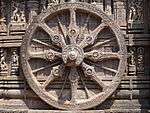Sambalpur
Sambalpur (![]()
Sambalpur | |
|---|---|
City | |
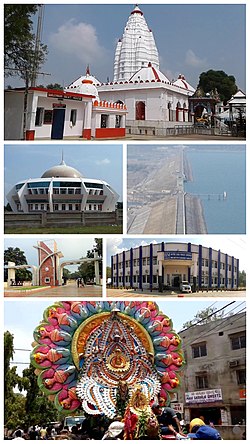 From top left to right: Samaleswari Temple, Dr APJ Abdul Kalam Planetarium, Hirakud Reservoir, Sambalpur University, Indian Institute of Management Sambalpur, and the Sitalsasthi Carnival | |
| Nickname(s): Handloom City | |
 Sambalpur Location in Odisha, India  Sambalpur Sambalpur (India) | |
| Coordinates: 21.47°N 83.97°E | |
| Country | |
| State | |
| District | Sambalpur |
| Named for | Maa Samaleswari |
| Government | |
| • Type | Municipal Corporation |
| • Body | Sambalpur Municipal Corporation (SMC)
Member of legislative Assembly – Jay Narayan Mishra BJP Member of parliament – Nitesh Ganga Deb BJP Mayor - (vacant) Collectorate- Shubham Saxena IAS |
| Area | |
| • Total | 89 km2 (34 sq mi) |
| Area rank | 4th |
| Elevation | 135 m (443 ft) |
| Population (2011) | |
| • Total | 269,575 |
| • Rank | 133thn India and [4th] rank in Odisha according to 2011 census |
| • Density | 3,000/km2 (7,800/sq mi) |
| Demonym(s) | Sambalpuria |
| Languages | |
| • Official | Odia, English |
| Time zone | UTC+5:30 (IST) |
| PIN | 768001-768XXX |
| Telephone code | 0663 |
| Vehicle registration | OD-15 |
| Literacy | 85.69% |
| Website | http://smcsambalpur.nic.in/ |
Overview
Sambalpur serves as the gateway to the bewitching Western Odisha, abounding in lush green forests, colorful wild-life, exquisite array of hills, waterfalls, rich tribal life & culture, folk songs & dances and a variety of monuments. Sambalpur has its own contribution in the cultural formentation of our country. Sambalpur is famous for its handloom textile works which has earned international fame for their unique pattern, design and texture. Nature has been bounteous to Sambalpur in more than one way. The wide diversity of flora and fauna in and around Sambalpur is an eloquent testimony to mother Nature’s generosity.
The city contains many famous temples, historic buildings and parks. Sambalpur is famous for premier educational institutes like Sambalpur University, Veer Surendra Sai Institute of Medical Sciences and Research (VIMSAR), Veer Surendra Sai University of Technology (VSSUT), Gangadhar Meher University, Indian Institute of Management Sambalpur and Odisha State Open University (OSOU). Hirakud Dam, the longest earthen dam in the world and the largest artificial lake of Asia, is at Sambalpur.[3]
After the independence of India, many commercial and government establishments sprung up in and around Sambalpur. It is one of the major railway junctions of Odisha with the headquarters of Sambalpur Railway Division under the East Coast Railway Zone. National Highway 53, National Highway 55 pass through the City and State Highway 10 & 15 originate from the city.[4]
Etymology

Sambalpur derives its name from the Goddess Samalei (Odia: ସମଲେଇ ମାଁ), who is regarded as the reigning deity of the region.[5] The region in which Sambalpur city is located was also known as Hirakhanda[6] from ancient times. In history, it has also been known as "Sambalaka". Claudius Ptolemy described the place as "Sambalak".
History
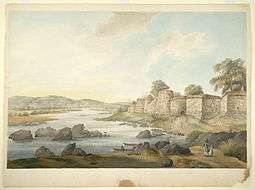
Sambalpur is one of the ancient places of India, with recorded settlements in the prehistoric age. There are prehistoric artifacts discovered that point to this.[8] Some historians identify it to the city of "Sambalaka" mentioned in the 2nd century Roman text "Geographia, an ancient atlas and a treatise Cartography" by Ptolemy. It is mentioned that the city produces diamonds.[9] In the 4th century CE, Gupta emperor conquered the territory of "Dakshina Koshala", comprising roughly present day Sambalpur, Vilaspur, and Raipur.[10] Later in early 6th century CE Chalukya king Pulakesin II is said to have conquered south Kosala by defeating the then Panduvamsi king Balarjuna Sivagupta.[11] The next dynasty to rule South Kosala was the Sombvamsi dynasty. Somavamshi King Janamajaya-I Mahabhavagupta (Circa 882–922 CE ) consolidated the eastern part of Kosala comprising the modern undivided Sambalpur and Bolangir districts and established matrimonial relationship with the Bhauma-Kara dynasty ruling over the coastal modern Odisha. After Uddyotakeshari(c. 1040–1065 C.E.), the Somavamshi kingdom declined gradually. The dynasty lost its territories to the Nagas in the north-west, and the Gangas in the south.[12] After decline of Somvamshis the area came under Telugu Chodas for a short period. The last Telugu Choda king of south Kosala was Somesvara III who was defeated by Kalachuri king Jajalladeva-I around 1119 CE.[13][14] The kalachuris had an intermittent conflict with Ganga Dynasty of Utkala (Present day coastal Odisha). Ultimately Kalachuris lost the SambalPur Sonepur region to Gangas during reign of Anangabhima Deva-III (1211–1238 C.E.).[15] The Ganga kingdom ruled Sambalpur region for 2 more centuries. However they faced aggression of the Bengal sultanate from north and Vijayanagara and Bahmani empires of south. This incessant struggles weakened the Ganga hold on Sambalpur . Ultimately Ramai Deva, a Chauhan Rajput from North India founded Chauhan rule in western Orissa.[16]
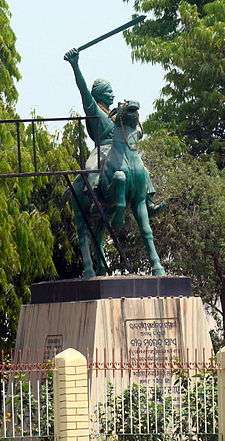
Sambalpur came under the Bhonsle of Nagpur when the Maratha conquered Sambalpur in 1800. After the Third Anglo-Maratha War in 1817, the British Government returned Sambalpur to the Chauhan king, Jayant Singh, but his authority over the other princely states was taken out.[17][18]
In January 1896, Hindi was made official language of Sambalpur, by abolishing Odia language, which after violent protests by people was reinstated again.[19] During the partition of Bengal in 1905 Sambalpur and the adjacent Odia-speaking tracts were amalgamated with the Odisha Division under Bengal Presidency. Bengal's Odisha division became part of the new province of Bihar and Odisha in 1912, and in April 1936 became the separate province of Odisha, with addition of Undivided Ganjam and Koraput districts from Madras Presidency.[20] After Indian Independence on 15 August 1947, Odisha became an Indian state. The rulers of the princely states of Western Odisha acceded to the Government of India in January 1948 and became part of Odisha state.
From 1825 to 1827, Lieutenant Colonel Gilbert (1785–1853), later Lieutenant General Sir Walter Gilbert, 1st Baronet, G.C.B., was the political agent for the South West Frontier with headquarters at Sambalpur. He made a few paintings during his stay at Sambalpur by an unknown artist which are currently with the British Library and Victoria and Albert Museum.[21]
Vajrayana Buddhism
Although it is generally accepted that Tantric Buddhism first developed in the country of Uddiyana or Odra Desha under King Indrabhuti, there is an old and well known scholarly dispute as to whether Uddiyana or Odra was in the Swat valley, Odisha or some other place.
Indrabhuti, the oldest known king of Sambalpur, founded Vajrayana, while his sister, who was married to Yuvaraja Jalendra of Lankapuri (Suvarnapur), founded Sahajayana. These new Tantric cults of Buddhism introduced the mantra, mudra and mandala along with six Tantric Abhicharas (practices) such as Marana, Stambhana, Sammohana, Vidvesan, Uchchatana and Vajikarana. The Tantric Buddhist sects made efforts to raise the dignity of the lowest of the low of the society to a higher plane. It revived primitive beliefs and practices a simpler and less formal approach to the personal god, a liberal and respectful attitude towards women and denial of caste system.[22]
From the seventh century A.D. onwards, many popular religious elements of heterogeneous nature were incorporated into Mahayana Buddhism which finally resulted in the origin of Vajrayana, Kalachakrayana and Sahajayana Tantric Buddhism. Tantric Buddhism first developed in Uddiyana, a country which was divided into two kingdoms, Sambhala and Lankapuri. Sambhala has been identified with Sambalpur and Lankapuri with Subarnapura (Sonepur).[23]
Geography and climate
| Sambalpur | ||||||||||||||||||||||||||||||||||||||||||||||||||||||||||||
|---|---|---|---|---|---|---|---|---|---|---|---|---|---|---|---|---|---|---|---|---|---|---|---|---|---|---|---|---|---|---|---|---|---|---|---|---|---|---|---|---|---|---|---|---|---|---|---|---|---|---|---|---|---|---|---|---|---|---|---|---|
| Climate chart (explanation) | ||||||||||||||||||||||||||||||||||||||||||||||||||||||||||||
| ||||||||||||||||||||||||||||||||||||||||||||||||||||||||||||
| ||||||||||||||||||||||||||||||||||||||||||||||||||||||||||||
Sambalpur is located at 21°.27' North Latitude and 83°.58' East Longitude. The average elevation is 150.75 metres (494.6 ft) above the mean sea level. Sambalpur falls under the Zone-3 seismic number, which shows the possibility of an earthquake.[25]
Sambalpur lies on the bank of the river Mahanadi. The river flows to the west of the city and separates Burla from Sambalpur and Hirakud. The Hirakud Dam lies upstream of Sambalpur. Budharaja is a small reserve forest located within the city. Sambalpur experiences an extreme type of climate with hot and dry summers followed by humid monsoons and cold winters. The hot season commences from the first week of March and lasts until the second half of June. In May, the temperature rises to 47 °C (117 °F). In December, the temperature comes down to 5 °C (41 °F).[26] Sambalpur gets rainfall from the south western monsoon. The most pleasant months in Sambalpur are from October to February, during which time the humidity and heat are at their lowest. During this period, temperatures during the day stay below 30 °C (86 °F) and drop to about 20 °C (68 °F) at night. This season is followed by a hot summer, from March to May. The summer gives way to the monsoon season. Since 1982 as per the data available with District Emergency section, Sambalpur, there has not been a single occurrence of cyclone in Sambalpur. There are possibilities of strong winds with the speed of 53 km/h (33 mph) before the onset of monsoon.[25] The relative humidity is high during the rainy season, generally being over 75%. After the rainy season the humidity gradually decreases and the weather becomes dry towards the winter. The best time to visit Sambalpur is between September and March. The heaviest-ever recorded rainfall in Sambalpur was 581.9 mm (22.91 in) in 1982, which was the highest ever in Odisha until September 2010.[27] The areas of the Sambalpur town on Mahanadi river sides/low-lying areas are prone to flooding.[25]
| Climate data for Sambalpur, Odisha (Normals: 1901–2000, Records: 1889–2009) | |||||||||||||
|---|---|---|---|---|---|---|---|---|---|---|---|---|---|
| Month | Jan | Feb | Mar | Apr | May | Jun | Jul | Aug | Sep | Oct | Nov | Dec | Year |
| Record high °C (°F) | 33.9 (93.0) |
37.8 (100.0) |
44.7 (112.5) |
46.6 (115.9) |
47.7 (117.9) |
47.4 (117.3) |
42.9 (109.2) |
40.0 (104.0) |
39.9 (103.8) |
40.9 (105.6) |
36.1 (97.0) |
34.1 (93.4) |
47.7 (117.9) |
| Average high °C (°F) | 27.6 (81.7) |
30.1 (86.2) |
35.0 (95.0) |
39.3 (102.7) |
41.4 (106.5) |
36.9 (98.4) |
31.1 (88.0) |
30.7 (87.3) |
31.7 (89.1) |
31.7 (89.1) |
29.4 (84.9) |
27.2 (81.0) |
32.7 (90.8) |
| Average low °C (°F) | 12.6 (54.7) |
15.1 (59.2) |
19.0 (66.2) |
23.5 (74.3) |
27.0 (80.6) |
26.7 (80.1) |
24.9 (76.8) |
24.8 (76.6) |
24.6 (76.3) |
21.8 (71.2) |
16.2 (61.2) |
12.1 (53.8) |
20.7 (69.3) |
| Record low °C (°F) | 3.6 (38.5) |
5.2 (41.4) |
8.8 (47.8) |
14.4 (57.9) |
16.0 (60.8) |
17.0 (62.6) |
18.3 (64.9) |
16.8 (62.2) |
17.8 (64.0) |
11.5 (52.7) |
7.8 (46.0) |
3.8 (38.8) |
3.6 (38.5) |
| Average precipitation mm (inches) | 14.2 (0.56) |
28.0 (1.10) |
20.9 (0.82) |
14.2 (0.56) |
22.7 (0.89) |
218.9 (8.62) |
459.0 (18.07) |
487.5 (19.19) |
243.5 (9.59) |
56.6 (2.23) |
17.6 (0.69) |
4.8 (0.19) |
1,587.9 (62.51) |
| Source: India Meteorological Department[28][29] | |||||||||||||
Transport
Roads
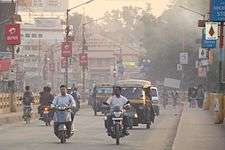
Sambalpur has a well networked transport facility for commercial and public transportation. It is connected to the rest of Odisha and India by national highway – NH 53/Economic Corridor 1 (EC1), which is a part of Asian Highway-AH46 (Mumbai-Kolkata Highway). NH 55 connects with Cuttack and Bhubaneswar, State Highway 15 connects with Sonepur, State Highway 10 (SH10) connects with Jharsuguda and Rourkela and the new Biju Expressway (under construction) will connect Rourkela-Sambalpur-Jagdalpur.[30]
Rail
Sambalpur is one of the three railway divisions under East Coast Railway zone of Indian Railways. Sambalpur (SBP) is a major railway station in Odisha and headquarters of Sambalpur railway division. This railway station is the cleanest railway station of East Coast Railway declared by Indian Railway. There are four other railway stations serving Sambalpur, viz. Sambalpur City Railway Station(SBPY), Sambalpur Road Railway Station(SBPD), Hirakud (HKG), across the Mahanadi and Maneswar Railway Station(MANE).
Air
The nearest airport is Veer Surendra Sai Airport, Jharsuguda (62 km, 39 mi) and Biju Patnaik International Airport, Bhubaneswar is located at a distance of (325 km, 202 mi).
Demographics
| Year | Pop. | ±% |
|---|---|---|
| 1891 | 14,571 | — |
| 1901 | 12,870 | −11.7% |
| 1941 | 17,079 | +32.7% |
| 1950 | 23,525 | +37.7% |
| 1961 | 38,915 | +65.4% |
| 1971 | 64,675 | +66.2% |
| 1981 | 110,283 | +70.5% |
| 1991 | 189,611 | +71.9% |
| 2001 | 226,469 | +19.4% |
| 2011 | 269,565 | +19.0% |
| 1891 to 1981 data of Sambalpur Municipality; from 1991 onwards the data presented is of Sambalpur Municipal Corporation Area | ||
Sambalpur city is governed by a Municipality which comes under Sambalpur Municipal Corporation Area. As of 2011 India census,[32] Although Sambalpur city has a population of 183,383, its urban population is 269,575, of whom 138,826 are males and 130,749 are females;[33] this includes Burla and Hirakud. Sambalpur has an average literacy rate of 85.69%; which male literacy is 90.30 and female literacy is 80.92 percent. The sex ratio is 942 and the child sex ratio is 882. The total children (0–6) in Sambalpur city were 18,555 as per the Census India report of 2011. There were 9,857 boys while 8,698 were girls.
Economy
The economy of Sambalpur is basically dependent on trade. Most of the residents are either salaried or self-employed. Forest products play an important role in the economy in terms of contribution to revenue and domestic product. Kendu leaf, Coromandel ebony or East Indian ebony (Diospyros melanoxylon) also forms part of the local economy, with many bidi manufacturing units functioning in Sambalpur.[34]
Gole Bazaar is the main merchandising area of the city. It is famous for handloom and other textile products.[35][36] Other merchandising areas are Khetrajpur, Fatak, V.S.S. marg, Budharaja and farm road. Budharaja is the central hub of the malls and jewellery shops.
Mahanadi Coalfields Limited, a subsidiary of Coal India Limited located at Sambalpur, produced 100.28 million tonnes (98.70 million long tons; 110.54 million short tons) of coal and had a profit before tax during 2010–2011 at Rs 4039.30 crore.[37] Hirakud, in the vicinity of Sambalpur, was conceptualized as an industrial town by the erstwhile Chief Minister of Odisha, Biju Patnaik. On completion of the Hirakud Dam, power intensive industries such as aluminium smelters, cable manufacturing, steel re-rolling mills etc. established their presence in Hirakud. In the 1970s, Hirakud was a major industrial centre of Odisha, perhaps next only to Rourkela. At this point in time however, the main functional unit at Hirakud is the aluminium smelter of Hindalco and its associated units. The smelter set up by Indal in 1959 at Hirakud and later acquired by Hindalco, was the country's second aluminium smelter operating on grid power sourced from the hydro power station of the Hirakud Dam.[3] It was the first in India to adopt clean coal combustion technology that uses a circulating fluidised bed, which is considered environmentally friendly.[3] Currently the smelter has a capacity of 213,000 tonnes per year (210,000 long tons per year; 235,000 short tons per year), and provides employment to around 1700 persons.[3]
Education
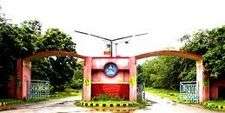
The pre-collegiate medium of instruction in schools is predominantly English and Odia. The medium of instruction in educational institutions after matriculation in colleges is English. Other media of instruction also exist in Sambalpur. Schools and colleges in Sambalpur are either government-run or run by private trusts and individuals. The schools are affiliated with either the Orissa State Board under BSE or CHSE, Indian Certificate of Secondary Education (ICSE) and the Central Board for Secondary Education (CBSE). After completing 10 years of schooling in secondary education, students enroll in higher secondary school, specialising in one of the three streams – Arts, Commerce or Science.
Since the 2000s, there have been a large number of professional institutions established in a variety of fields. The earliest schools established in Sambalpur were the CSB Zilla School (1852) and the Lady Lewis Girls High School (1942).[38] VSS Medical College was established in 1959 and VSSUT in 1956. High School for Blind (1972) and High School for Deaf and Dumb (1972), Burla are Govt. educational institutions imparting education to physically challenged children.[38]

Sambalpur Kala Parishad is the pioneering organisation for the promotion of Sambalpuri dance, and has been responsible for the revolutionary growth of this dance.[39] It imparts education and training on this form of dance.
Educational institutions in the city include Gangadhar Meher University,[40] Women's College, Netaji Subhash Chandra Bose College, Lala Lajpat Rai Law College, Silicon Institute of Technology, Sambalpur, Delhi Public School, Kendriya Vidyalaya, St. Joseph's Convent Higher Secondary School (SJC-SBP), Gurunanak Public School, Madnawati Public School (MPS), Indian Public School (IPS), St. John's School, Seven Hills Residential School (SHRS), Sri Aurobindo School (SAIIE&R) and DAV Public School. A new Indian Institute of Management, Sambalpur (IIM) has been set up in the city. The Sambalpur chapter of the Institute of Cost Accountants of India[41] was set up in 2010.[42]
Culture
Sambalpur Lok Mahotsav
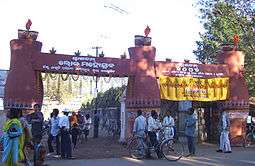
A cultural manifestation of the hidden age-old traditional performing art of a vast geographical area is possible through this annual celebration of the festival called Lok Mahotsav. This festival is a reflection of the socio- anthropological evolution of the people of India. Lok Mahotsav shows the integrity and unison of the heritage, culture, music and lifestyle of Western Odisha. Live performances of folk music and dance from all parts of India are shown under one splendid stage.[43]
Sitalsasthi Carnival
This is the marriage ceremony of the god Siva and goddess Parvati. Sitalsasthi is a carnival of folk dance and music along with decorated stands of gods and goddesses. People from all walks of life participate in large numbers in the carnival. Artists from different states of India take part in the carnival making it a colourful extravaganza.[44]
Kalki Avatar and Sambalpur
Kalachakra tantra was first taught by the Buddha to King Indrabhuti, the first dharmaraja of Shambhala.[45] It is widely believed that the next Hindu avatar known as Kalki will be born at Sambalpur or Shambhala, as this place was known in olden times. There are several mentions of the place Shambhala in different Hindu and Buddhist religious texts as the birthplace of Kalki. The Mahabharatra (Vana Parva, 190.93–97) and Srimad-Bhagavatam Bhag.12.2.18 give reference of Shambhala as the birthplace.[46]
Tourism
The world-famous Hirakud Dam, built in 1956 across the Mahanadi River, about 15 km (9.3 mi) from Sambalpur, is a major tourist attraction. It is one of the longest dams in the world, about 26 km (16 mi) in length. It also forms the biggest artificial lake in Asia, with a reservoir covering 743 km2 (287 sq mi) at full capacity with a shoreline of over 640 km (400 mi).[47] It also attracts a large number of migratory birds in winter.
The Leaning Temple of Huma, located about 25 km (16 mi) from Sambalpur, built in the 17th century, leans at an angle of approximately 47 degrees to the west. (Pasayat, 1998, 2003, 2004, 2007, 2008).[48] It is one of a kind in India.
Samaleswari Temple is the main temple of the goddess Samaleswari, located on the banks of river the Mahanadi. Sambalpur owes its name to her.[49]
Chiplima[50] (Chipilima Hydro Electric Project (CHEP)) located about 37 km (23 mi) from Sambalpur, is known for a natural fall (24.38 m (80.0 ft) in height) harnessed for generating electricity. It is an ideal picnic spot and famous for Ghanteswari Temple, the presiding deity of the place. This temple played an important role for river navigation in the past.[50]
Lost Temples of Hirakud Dam
These are remnants of temples submerged after the dam was completed in 1957. In summer, due to the receding water of the dam, the structures become visible. These hidden treasures have finally caught the attention of historians and steps are being taken to understand the historical significance of these temples which periodically go under water, only to resurface again. Many temples have been destroyed after 58 years of underwater existence. However, some remain intact.[51]
Interest in these lost temples has been rekindled after two stones, etched with writing ('Shila Lekha'), were recovered from what is believed to be the Padmaseni temple of the submerged Padmapur village.[52] The temples located inside the reservoir area were part of the then Padmapur, one of the oldest and most populous villages in the region prior to the dam construction.[51] More than 200 temples were submerged by the dam; nearly 150 temples have either perished or are underwater and about 50 are visible during summer. These lost temples present excellent opportunities for scuba diving enthusiasts to explore under the Hirakud Dam. These temple are visible to visitors on boats only during the summer months of May and June.
Politics
Sambalpur is part of Sambalpur (Lok Sabha constituency).[53] Sitting MP from Sambalpur is Mr Nitesh Gangadev of Bhartiya Janata Party (BJP). The current MLA of Sambalpur (Odisha Vidhan Sabha constituency) is Jayanarayan Mishra of Bhartiya Janata Party (BJP). Previous MLAs from this seat were Dr. Raseswari Panigrahi (BJD), who won this seat in 2014; Durgashankar Pattanaik of INC,in 1995 and 1990; Sraddhakar Supakar of INC in 1985; Ashwini Kumar Guru of INC (I) in 1980; and Late Dr. Jhasaketan Sahu of JNP in 1977. Sriballav Panigrahi of Indian National Congress represented Sambalpur in the Odisha Lesgislative Assembly in 1971 and 1973.[54]
See also
- Sambalpuri cinema
- Sambalpuri language
- Sambalpuri saree
References
- "Population of UAs/Towns" (pdf). he Registrar General & Census Commissioner, India. p. 3.
- https://censusindia.gov.in/2011census/dchb/DCHB.html
- "Operations | Manufacturing locations | Hirakud". Hindalco. 19 August 2009. Retrieved 23 March 2012.
- "NH 42 (261 km: NH-6@Sambalpur – Redhakhol – Anugul – Dhenkanal – NH-5@Nergundi)". orissalinks.com. Archived from the original on 9 December 2010. Retrieved 13 April 2015.
- "(dead link)". samaleswari.org. Archived from the original on 8 October 2016. Retrieved 13 April 2015.
- "Sambalpur – Jharsuguda, a new destination for industrial development in Odisha. | Sambalpur News". mysambalpur.in. Retrieved 13 April 2015.
- Claus, P.J.; Diamond, S.; Mills, M.A. (2003). South Asian Folklore: An Encyclopedia : Afghanistan, Bangladesh, India, Nepal, Pakistan, Sri Lanka. Special -Reference. Routledge. p. 521. ISBN 978-0-415-93919-5. Retrieved 11 June 2019.
- McCrindle, J.W.; Jain, R.C. (1885). Ancient India, as Described by Ptolemy: Being a Translation of the Chapters which Describe India and Central and Eastern Asia in the Treatise on Geography Written by Klaudios Ptolemaios, the Celebrated Astronomer, with Introductions, Commentary, and Index. McGrindle's ancient India. Today & Tomorrow's Printers & Publishers. p. 169. Retrieved 10 June 2019.
- Sharma, T.R. (1989). A Political History of the Imperial Guptas: From Gupta to Skandagupta. Concept Publishing Company. p. 32. ISBN 978-81-7022-251-4. Retrieved 10 June 2019.
- Dikshit, D.P. (1980). Political History of the Chālukyas of Badami. Abhinav Publications. p. 90. ISBN 978-0-8364-0645-0. Retrieved 11 June 2019.
- Sen, S.N. (1999). Ancient Indian History and Civilization. New Age International. p. 430. ISBN 978-81-224-1198-0. Retrieved 13 June 2019.
- Panigrahi, Krishna Chandra (1981). Chronology of the Bhauma-Karas and the Somavamsis of Orissa. Panigrahi. p. 17. OCLC 17780838.
- Panigrahi, Krishna Chandra (1981). Chronology of the Bhauma-Karas and the Somavamsis of Orissa. Panigrahi. p. 45. OCLC 17780838.
- Archaeological Survey of India; India. Dept. of Archaeology (1987). Epigraphia Indica. Manager of Publications. p. 121. Retrieved 13 June 2019.
- O'malley, L.S.S. (2007). Bengal District Gazetteer : Sambalpur (in Indonesian). Concept Publishing Company. p. 21. ISBN 978-81-7268-139-5. Retrieved 13 June 2019.
- Sambalpur Archived 26 February 2011 at the Wayback Machine. Remunda.com. Retrieved on 20 January 2011.
- O'malley, L.S.S. (2007). Bengal District Gazetteer : Sambalpur (in Indonesian). Concept Publishing Company. p. 26. ISBN 978-81-7268-139-5. Retrieved 13 June 2019.
- Untitled-13 Archived 17 June 2013 at the Wayback Machine. (PDF). Retrieved on 20 January 2011.
- Biswamoy Pati (1992). "Of Movements, Compromises and Retreats: Odisha, 1936–1939". Social Scientist. 20 (5/6): 64–88. JSTOR 3517932.
- "Prints & drawings collection summary". India Office Select Materials. Archived from the original on 3 September 2008.
- Bargarh District Archived 7 February 2011 at the Wayback Machine. Bargarh.nic.in. Retrieved on 20 January 2011.
- Buddhist Remains in Western Odisha. Scribd.com. Retrieved on 20 January 2011.
- http://www.worldweatheronline.com/Sambalpur-weather-averages/Orissa/IN.aspx
- Microsoft Word – final report sambalpur 8 Dec.doc. (PDF). Retrieved on 20 January 2011.
- "District Rainfall (mm.) For Last Five Years". Hydromet Division, India Meteorological Department. Archived from the original on 5 December 2010.
- Microsoft Word – envis-newsletter-2005.doc Archived 21 July 2011 at the Wayback Machine. (PDF). Retrieved on 20 January 2011.
- "Ever Recorded Maximum Temperature, Minimum Temperature and 24 Hours Heaviest Rainfall upto 2010" (PDF). Ministry of Earth Sciences, Government of India. Archived from the original (PDF) on 21 May 2013. Retrieved 13 December 2016.
- "Monthly mean maximum & minimum temperature and total rainfall based upon 1901–2000 data" (PDF). Ministry of Earth Sciences, Government of India. Archived from the original (PDF) on 21 May 2013. Retrieved 13 December 2016.
- Welcome To Sadbhav Engineering Ltd Archived 23 August 2010 at the Wayback Machine. Sadbhaveng.com. Retrieved on 20 January 2011.
- Ghosh, A.; Ahmad, S.S.; Maitra, S.; Institute of Social Sciences (New Delhi, India) (1995). Basic Services for Urban Poor: A Study of Baroda, Bhilwara, Sambalpur, and Siliguri. Institute of Social Sciences and Concept Publishing Company. p. 133. ISBN 9788170225515. Retrieved 13 April 2015.
- "Census of India 2001: Data from the 2001 Census, including cities, villages and towns (Provisional)". Census Commission of India. Archived from the original on 16 June 2004. Retrieved 1 November 2008.
- "Sambalpur (Sambalpur Town) City Population Census 2011". Census2011.co.in. Retrieved 23 March 2012.
- Kendu Leaf Trade: An Eco-Friendlyway of Sustenance Archived 20 September 2016 at the Wayback Machine. Shvoong.com. Retrieved on 20 January 2011.
- "Sambalpur Shopping – Shopping in Sambalpur, Shopping in Sambhalpur Orissa". bharatonline.com. Retrieved 13 April 2015.
- "Sambalpur Tourist Attractions | PlanetWare". planetware.com. Archived from the original on 20 April 2015. Retrieved 13 April 2015.
- "Annual Report & Accounts 2010–2011 Mahanadi Coalfields Limited" (PDF). Retrieved 13 April 2015.
- "Welcome To Our Website : RTI Central Monitoring Mechanism by Govt. of Orissa [RTI CMM v2.1]". Rtiorissa.gov.in. Archived from the original on 18 November 2011. Retrieved 23 March 2012.
- Prafulla Kumar Mohapatra (21 May 2011). "Dancing the Sambalpuri way". Deccan Herald. Retrieved 23 March 2012.
- "Archived copy". Archived from the original on 29 March 2016. Retrieved 19 October 2009.CS1 maint: archived copy as title (link)
- http://icmai.in/icmai/index.php
- http://icmai.in/Chapters-Website/index.php?chapterID=77&parent=EIRC
- "Lok Mahotasav – 2012". sambalpur.nic.in. Archived from the original on 11 March 2012. Retrieved 25 March 2012.
- "The Famous Sital Sasthi Yatra". Sambalpur.nic.in. Archived from the original on 16 July 2011. Retrieved 20 January 2011.
- Shambhala Times Community News Magazine » Recapping the Rinchen Terdzo in Odisha, India. Shambhalatimes.org (23 March 2009). Retrieved on 20 January 2011.
- Kalki The Next Avatar of God. Stephen-knapp.com. Retrieved 20 January 2011.
- Hirakud Dam Archived 2 November 2008 at the Wayback Machine. Sambalpur.nic.in. Retrieved on 20 January 2011.
- Orissa Tourism – Huma, The Leaning Temple Of Lord Shiva Archived 10 May 2016 at the Wayback Machine. Orissadiary.com. Retrieved on 20 January 2011.
- Welcome to Maa Samaleswari Temple, Sambalpur, Odisha Archived 8 October 2016 at the Wayback Machine. Samaleswari.org. Retrieved on 20 January 2011.
- Tourist Spots In Sambalpur District Archived 16 July 2011 at the Wayback Machine. Sambalpur.nic.in. Retrieved on 20 January 2011.
- "Temples resurface in Hirakud bed". The Times of India. Retrieved 13 April 2015.
- "Ancient rock edicts discovered in Odisha –". OdishaSunTimes.com. Retrieved 13 April 2015.
- "Assembly Constituencies – Corresponding Districts and Parliamentary Constituencies of Odisha" (PDF). Election Commission of India. Archived from the original (PDF) on 4 March 2009. Retrieved 18 September 2008.
- "State Elections 2004 – Partywise Comparison for 128-Sambalpur Constituency of Odisha". Election Commission of India. Retrieved 18 September 2008.
External links
| Wikimedia Commons has media related to Sambalpur. |
- Official website

